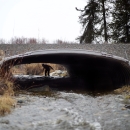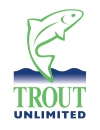States
MichiganThis project will replace a failing culvert on Claybank Creek in Michigan. This culvert is too small, inhibits fish passage fish passage
Fish passage is the ability of fish or other aquatic species to move freely throughout their life to find food, reproduce, and complete their natural migration cycles. Millions of barriers to fish passage across the country are fragmenting habitat and leading to species declines. The U.S. Fish and Wildlife Service's National Fish Passage Program is working to reconnect watersheds to benefit both wildlife and people.
Learn more about fish passage , and disrupts natural ecological processes. Claybank Creek is a high-quality, cold-water stream that boasts a robust population of high priority brook trout and molted/slimy sculpin. Replacing the existing culvert would reopen more than three miles of cold water and valuable spawning habitat to resident and migratory fish. This is the lowest crossing in the watershed and its replacement will restore full stream connectivity. The newly constructed structure structure
Something temporarily or permanently constructed, built, or placed; and constructed of natural or manufactured parts including, but not limited to, a building, shed, cabin, porch, bridge, walkway, stair steps, sign, landing, platform, dock, rack, fence, telecommunication device, antennae, fish cleaning table, satellite dish/mount, or well head.
Learn more about structure will benefit neighboring communities by mitigating flood damage risk, maintaining access to emergency services in a remote area, and increase public access for recreation.
Project Quick Facts:
| Project Status | In Development |
| Location | MI, Manistee County |
| NFPP Project Funding | 300,000 |
| Restoration Techniques | Culvert Replacement |
| Accomplishments | 4 Stream Miles Reopened |
| Partner Project Lead | Trout Unlimited |
The National Fish Passage Program combines technical expertise with a track record of success.
Implemented primarily through the Service's Fish and Wildlife Conservation Offices, the National Fish Passage Program provides financial and technical assistance to partners across the country. Since 1999, the program has worked with over 2,000 local communities, Tribes, and private landowners to remove or bypass over 3,400 barriers to fish passage and reopen access to over 61,000 miles of upstream habitat for fish and other animals. Staff have expertise in fish migration and biology as well as financial, engineering, and planning assistance to communities, Tribes, and landowners to help them remove barriers and restore rivers for the benefit both fish and people.
Fish passage project proposals can be initiated by any individual, organization, government, or agency. However, proposals must be submitted and completed in cooperation with a Fish and Wildlife Conservation Office. (Please note that fish passage projects being used for federal or state compensatory mitigation or required by existing federal or state regulatory programs are not eligible for funding through the National Fish Passage Program.)
CONTACT A FISH PASSAGE COORDINATOR IN YOUR AREA TO GET STARTED.


